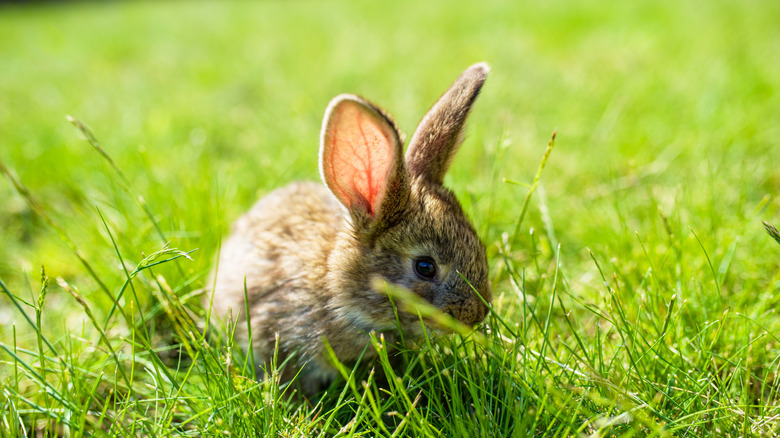How To Determine The Age Of A Baby Cottontail Rabbit
You may have seen cottontail rabbits hopping around in your yard. They're cute and brown with white, bushy tails, and they look similar to some types of domestic rabbits. However, cottontails are wild animals that shouldn't be kept in captivity. That being said, you may come across baby cottontails and wonder whether they're orphaned or abandoned and in need of human help. One of the key things to note before handling and feeding baby cottontails is their age — this may determine whether it's appropriate to intervene. So, you need to be able to tell how old a wild bunny is if you encounter one.
In general, if you come across young cottontail rabbits in the wild, it's best to leave them alone and see if the mother returns to them. Mothers only return to their nests at dawn and dusk to feed their young; outside of this, they stay away from the nest so as not to draw predators near. But if you're relatively sure the rabbits are on their own, you can tell how old they are by observing several distinct characteristics.
Newborn cottontails will be gray and hairless with pink noses and feet, and their eyes will be completely closed. By the three-to-four-day mark, they will be covered in a short coat of black fur, but their eyes will still be closed and their ears pressed against their head. The same goes as they near a week in age, but their brown topcoat will grow in by then.
Cottontail rabbits open their eyes at around 7 to 10 days of age
By the time they're a full week old, cottontail rabbits' eyes open, and they become more active. Between their second and fourth weeks of life, they can leave the nest, eat plants, and explore their surroundings. During this time, they'll still be nursing, so if you notice a nest of bunnies in your backyard, you'll want to check (from a distance!) to make sure the mother returns to the nest in the morning and the evening.
If you come across a disturbed nest, whether it's been found by your cat or dog, driven over by a lawn mower, or filled with rainwater, and realize you must remove one or more babies because they're injured, it's important to give them all your smell by gentle touching them. This will help them stick together. Bring any injured babies to a wildlife rehabilitation center or a vet that handles wild animals, and leave any unharmed babies alone in the nest.
You don't want to handle or transport any baby rabbits you don't have to because they can easily die from stress. According to the Missouri House Rabbit Society, toxins can disperse into rabbits' systems when they're overly stressed, afraid, or in pain. This leads to septicemia, aka blood poisoning, which is when bacteria enters the bloodstream and creates havoc for the animal. Septicemia is extremely serious and often fatal in rabbits. Even if rabbits look very young and small, if they've left the nest, there's a good chance they're already meant to be on their own.
By a month old, cottontail rabbits are independent
They may still be tiny (the size of a tennis ball!) and look brand new, but at just one month old, cottontail rabbits leave the nest and live completely independent lives. Generally, if a rabbit is running and making you chase it, it's fine to live on its own and doesn't need help. And what should they look like? Well, when they're fully grown, cottontails weigh between 2 and 4 pounds and are 15 to 19 inches long.
In the wild, cottontails' life expectancy is only two years. They are prey for many other wild animals, including foxes, weasels, and snakes, and face many other hardships. Nearly half of baby cottontails die within one month of being born, as they're quite vulnerable to extreme weather, predators, and intervention and accidents involving humans. There's a saying that references how rabbits reproduce often, and it's true. The breeding season is long for them, lasting from February to September, and female cottontails can have between three and seven litters per year.
Ultimately, the best thing you can do when you come across an undisturbed nest of baby cottontail rabbits is leave it alone. The babies will grow quickly, leave the nest within just a few weeks, and be hopping around your yard in no time. You can even learn how to identify rabbit tracks to keep track (pun intended) of your wild little friends.


